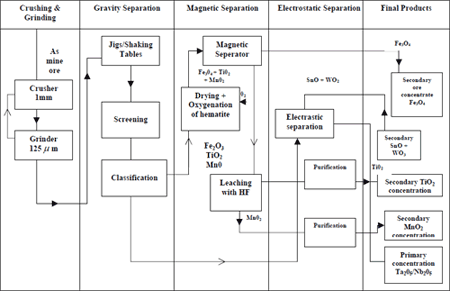The beneficiation process adopted in concentrating a particular ore is a function of the nature of the ore in terms of physico-mechanical and chemical characteristics of the ore. Basically, there are three stages that are involved and these are pre-concentration, primary concentration and concentration clean up. The choice of any or all of these depends on the characteristics of the ore (particularly the content of the principal concentrate) relative to associated minerals and impurities. The beneficiation process may be carried out by any or combination of the mineral beneficiation techniques. These techniques include wet gravity, magnetic, electro static and flotation and the associated contending technologies are pyrometallurgy, chlorination and hydrometallurgy. The correlation existing among the three variables of grades of tantalite, beneficiation and chemical extraction routes is provided in Table 2.
Table 2: Correlation between different Grades of Tantalite Ores, Beneficiation Routes and Chemical Extraction (milled from Adetunji et al)

Table 2 displays the beneficiation route and chemical extraction route suitable for different grades of tantalite ore assay. The very low-grade deposit (2-10%) is preferably beneficiated through preconcentration and pyrometallurgy technology. The concentrate in alloys and scraps containing between 40-100% primary metal are best recovered through chlorination. The natural tantalite ores, synthetic concentrates and high grade tin slags are best beneficiated through flotation, leaching, magnetic separation, electrostatic separation, classifications etc. deploying the hydrometallurgy technology.
The tantalite ore reserves investigated by had 38.87% tantalite ore concentrate except for the Otu deposit (see Table 1) which had an assay of 8.00% Ta2O5. This average tantalite assay in relation to Table 2, implies that the Nigerian tantalite deposits are candidates for hydrometallurgical beneficiation; except for the Otu deposit which needs to be pre concentrated to upgrade the ore to assay grade suitable for hydrometallurgical beneficiation. The conventional method for the beneficiation of tantalite mineral is the gravity separation technique due to the density of Ta – Nb minerals which allows concentration with other heavy metals. However, in the present effort, the focus is the concentration of multi-constituent of tantalum bearing minerals with a view to generating economic value for the secondary ore concentrates in the tantalum bearing minerals.
Our beneficiation effort proposed a model that combines the traditional gravity method of beneficiation of tantalite and niobium minerals with techniques that are capable of equally beneficiating TiO2, MnO2 and Fe2O3 as adjunct recovered concentrates.
A scheme of the proposed model is presented in Figure 3. The figure incorporates mainly gravity, magnetic and electrostatic separation techniques with leaching as adjunct beneficiation technique to generate the various secondary ore concentrates.

In the proposed model, as-mined tantalite ore is crushed, ground and sieved to 125 micron size in appropriate system. The screened ore is subjected to gravity separation technique where Ta2O5 / Nb2O5 and other associated minerals are concentrated. The Ta2O5 / Nb2O5 is separated from associated heavy metals such as wolframite, ilmenite which are electrically conducting through electrostatic separation.
The other heavy metals such as hematite, manganese oxide and rutile are roasted, dried and subsequently subjected to magnetic separation where the hematite transformed to ferromagnetic magnetite is concentrated from paramagnetic manganese and titanium ore minerals. The titanium/manganese ore are subsequently beneficiated through hydrometallurgy using leaching. This based on the work of Adetunji et al in terms of labour cost and simplicity of the process is best facilitated by direct dissolution in hydrogen fluoride (HF).
The effectiveness of the model is to be evaluated by optimizing the dissolution of the important metallic ore concentrates through the analysis of the chemical equilibria parameter. The result of this analysis will be a basis for the design and development of a pilot multi-constituent tantalite ore beneficiation technology.

